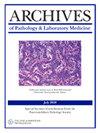Screening and Diagnosis of Rare Thalassemia Variants.
IF 3.7
3区 医学
Q2 MEDICAL LABORATORY TECHNOLOGY
引用次数: 0
Abstract
CONTEXT.— Rare thalassemia subtypes are often undiagnosed because conventional testing methods can only identify 23 common types of α- and β-thalassemia. OBJECTIVE.— To assess a comprehensive approach for the screening and diagnosis of rare thalassemia. DESIGN.— The study cohort included 72 individuals with suspected rare thalassemia variants. Screening was conducted by next-generation sequencing (NGS) combined with third-generation sequencing (TGS) and chromosomal microarray analysis (CMA)/copy number variation sequencing. RESULTS.— Of the 72 individuals with suspected rare thalassemia, 49 had rare α- or β-gene variants. NGS combined with gap polymerase chain reaction detected a total of 42 cases, resulting in a positive detection rate of 58.3%. Additionally, 4 α-globin genetic deletions were identified by TGS, which increased the variant detection rate by 5.6%. Two samples with a microdeletion of chromosome 16 or 11 were detected by CMA, which increased the detection rate by 2.8%. For one sample, reanalysis of the NGS and TGS data confirmed the presence of the β41-42/βN and βN/βN mosaic. The HBB:c.315 + 2delT mutation was initially reported in Guangdong Province, China. Two HBB gene mutations (HBB:c.315 + 5G>C and HBB:c.295G>A) and 4 rare HBA gene deletions (-11.1, -α27.6, -α2.4, and -α21.9) were initially identified in the Zhonshan region. The hematologic phenotypes of all rare cases in this study were clarified. CONCLUSIONS.— Rare thalassemia variants are more common than previously thought. Despite advancements in TGS, there is still no foolproof method for detection of all types of thalassemia. Thus, a comprehensive approach is necessary for accurate screening and diagnosis of rare thalassemia variants.罕见地中海贫血变异基因的筛查和诊断。
研究队列包括 72 名疑似罕见地中海贫血变异体的个体。结果:在 72 名疑似罕见地中海贫血患者中,49 人有罕见的 α 或 β 基因变异。NGS 结合间隙聚合酶链反应共检测出 42 例,阳性检测率为 58.3%。此外,TGS 还发现了 4 个 α-球蛋白基因缺失,使变异检出率提高了 5.6%。两个样本的 16 或 11 号染色体微缺失被 CMA 检测到,使检出率提高了 2.8%。对于一个样本,对 NGS 和 TGS 数据的重新分析证实了 β41-42/βN 和 βN/βN 嵌套的存在。HBB:c.315 + 2delT 突变最初在中国广东省被报道。中山地区最初发现了两个HBB基因突变(HBB:c.315 + 5G>C和HBB:c.295G>A)和4个罕见的HBA基因缺失(-11.1、-α27.6、-α2.4和-α21.9)。本研究明确了所有罕见病例的血液学表型。尽管 TGS 技术在不断进步,但仍没有一种万无一失的方法来检测所有类型的地中海贫血。因此,要准确筛查和诊断罕见地中海贫血变异型,必须采用综合方法。
本文章由计算机程序翻译,如有差异,请以英文原文为准。
求助全文
约1分钟内获得全文
求助全文
来源期刊
CiteScore
9.20
自引率
2.20%
发文量
369
审稿时长
3-8 weeks
期刊介绍:
Welcome to the website of the Archives of Pathology & Laboratory Medicine (APLM). This monthly, peer-reviewed journal of the College of American Pathologists offers global reach and highest measured readership among pathology journals.
Published since 1926, ARCHIVES was voted in 2009 the only pathology journal among the top 100 most influential journals of the past 100 years by the BioMedical and Life Sciences Division of the Special Libraries Association. Online access to the full-text and PDF files of APLM articles is free.

 求助内容:
求助内容: 应助结果提醒方式:
应助结果提醒方式:


